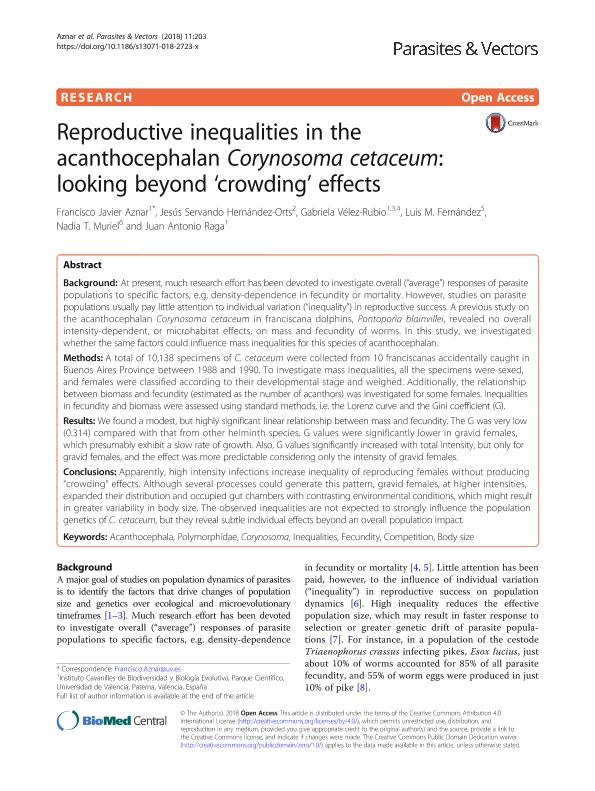Mostrar el registro sencillo del ítem
dc.contributor.author
Aznar Avendaño, Francisco Javier

dc.contributor.author
Hernández Orts, Jesús Servando

dc.contributor.author
Vélez Rubio, Gabriela Manuela

dc.contributor.author
Fernández, Luis M.
dc.contributor.author
Muriel, Nadia T.
dc.contributor.author
Raga, Juan Antonio
dc.date.available
2020-03-13T17:34:20Z
dc.date.issued
2018-03
dc.identifier.citation
Aznar Avendaño, Francisco Javier; Hernández Orts, Jesús Servando; Vélez Rubio, Gabriela Manuela; Fernández, Luis M.; Muriel, Nadia T.; et al.; Reproductive inequalities in the acanthocephalan Corynosoma cetaceum: looking beyond "crowding" effects; BioMed Central; Parasites and Vectors; 11; 203; 3-2018; 1-9
dc.identifier.issn
1756-3305
dc.identifier.uri
http://hdl.handle.net/11336/99491
dc.description.abstract
Background: At present, much research effort has been devoted to investigate overall (average) responses of parasite populations to specific factors, e.g., density-dependence in fecundity or mortality. However, studies on parasite populations usually pay little attention to individual variation (inequality) in reproductive success. A previous study on the acanthocephalan Corynosoma cetaceum in franciscana dolphins, Pontoporia blainvillei, revealed no overall intensity-dependent, or microhabitat effects, on mass and fecundity of worms. In this study, we investigated whether the same factors could influence mass inequalities for this species of acanthocephalan.Methods: A total of 10,138 specimens of C. cetaceum were collected from 10 franciscana dolphins accidentally caught in Buenos Aires Province between 1988-1990. To investigate mass inequalities, all the specimens were sexed, and females were classified according to their developmental stage and weighted. Additionally, the relationship between biomass and fecundity (estimated as the number of acanthors) was investigated for some females. Inequalities in fecundity and biomass were assessed using standard methods, i.e. the Lorenz curve and the Gini coefficient (G).Results: We found a modest, but highly significant linear relationship between mass and fecundity. The G was very low (0.314) compared with that from other helminth species. G values were significantly lower in gravid females, which presumably exhibit a slow rate of growth. Also, G values significantly increased with total intensity, but only for gravid females, and the effect was more predictable considering only the number of gravid females.Conclusions: Apparently, competition between reproducing females increases inequality without producing crowding effects. Although the mechanism whereby this occurs is unclear, gravid females, at higher intensities, expanded their distribution and occupied gut chambers with contrasting environmental conditions, which might result in greater variability in body size. The observed inequalities are not expected to strongly influence the population genetics of C. cetaceum, but they reveal subtle individual effects beyond an overall population impact.
dc.format
application/pdf
dc.language.iso
eng
dc.publisher
BioMed Central

dc.rights
info:eu-repo/semantics/openAccess
dc.rights.uri
https://creativecommons.org/licenses/by/2.5/ar/
dc.subject
Acanthocephala
dc.subject
Polymorphidae
dc.subject
Corynosoma
dc.subject
Inequalities
dc.subject.classification
Zoología, Ornitología, Entomología, Etología

dc.subject.classification
Ciencias Biológicas

dc.subject.classification
CIENCIAS NATURALES Y EXACTAS

dc.title
Reproductive inequalities in the acanthocephalan Corynosoma cetaceum: looking beyond "crowding" effects
dc.type
info:eu-repo/semantics/article
dc.type
info:ar-repo/semantics/artículo
dc.type
info:eu-repo/semantics/publishedVersion
dc.date.updated
2020-02-26T14:58:14Z
dc.journal.volume
11
dc.journal.number
203
dc.journal.pagination
1-9
dc.journal.pais
Reino Unido

dc.journal.ciudad
Londres
dc.description.fil
Fil: Aznar Avendaño, Francisco Javier. Universidad de Valencia; España
dc.description.fil
Fil: Hernández Orts, Jesús Servando. Universidad Nacional del Comahue. Centro de Investigación Aplicada y Transferencia Tecnológica en Recursos Marinos "Almirante Storni". - Provincia de Río Negro. Ministerio de Agricultura, Ganadería y Pesca. Centro de Investigación Aplicada y Transferencia Tecnológica en Recursos Marinos "Almirante Storni". Consejo Nacional de Investigaciones Científicas y Técnicas. Centro Científico Tecnológico Conicet Centro Nacional Patagónico. Centro de Investigación Aplicada y Transferencia Tecnológica en Recursos Marinos "Almirante Storni"; Argentina
dc.description.fil
Fil: Vélez Rubio, Gabriela Manuela. Universidad de Valencia; España. Consejo Nacional de Investigaciones Científicas y Técnicas; Argentina. Universidad de la República; Uruguay
dc.description.fil
Fil: Fernández, Luis M.. Ceiba Foundation for Tropical Conservation; Estados Unidos
dc.description.fil
Fil: Muriel, Nadia T.. No especifíca;
dc.description.fil
Fil: Raga, Juan Antonio. Universidad de Valencia; España
dc.journal.title
Parasites and Vectors

dc.relation.alternativeid
info:eu-repo/semantics/altIdentifier/url/https://parasitesandvectors.biomedcentral.com/articles/10.1186/s13071-018-2723-x
dc.relation.alternativeid
info:eu-repo/semantics/altIdentifier/doi/http://dx.doi.org/10.1186/s13071-018-2723-x
Archivos asociados
